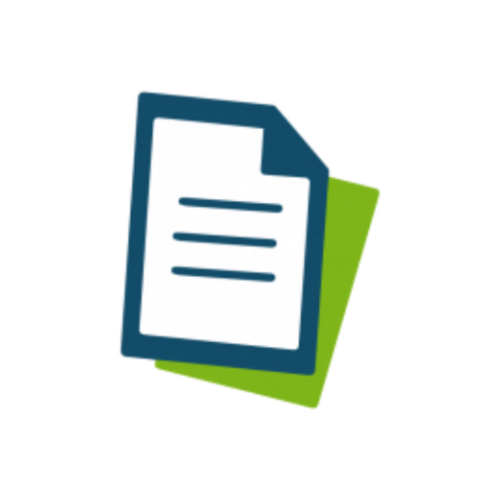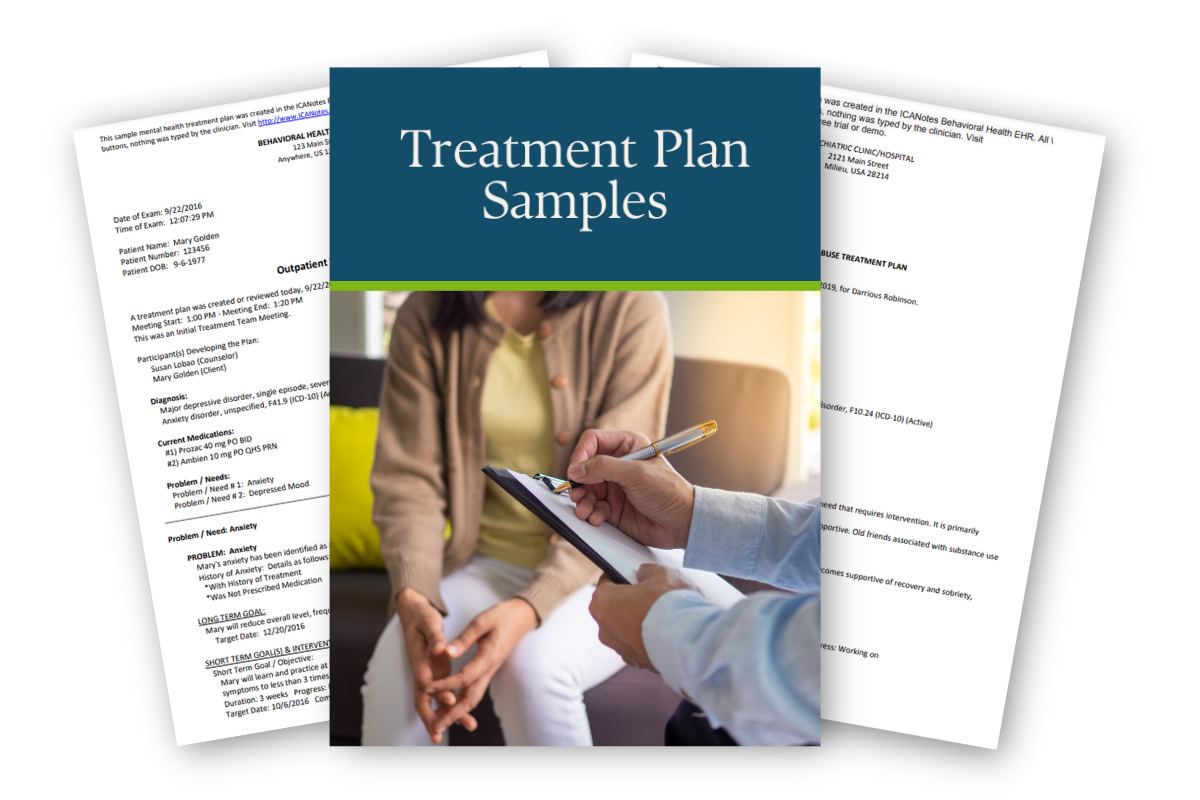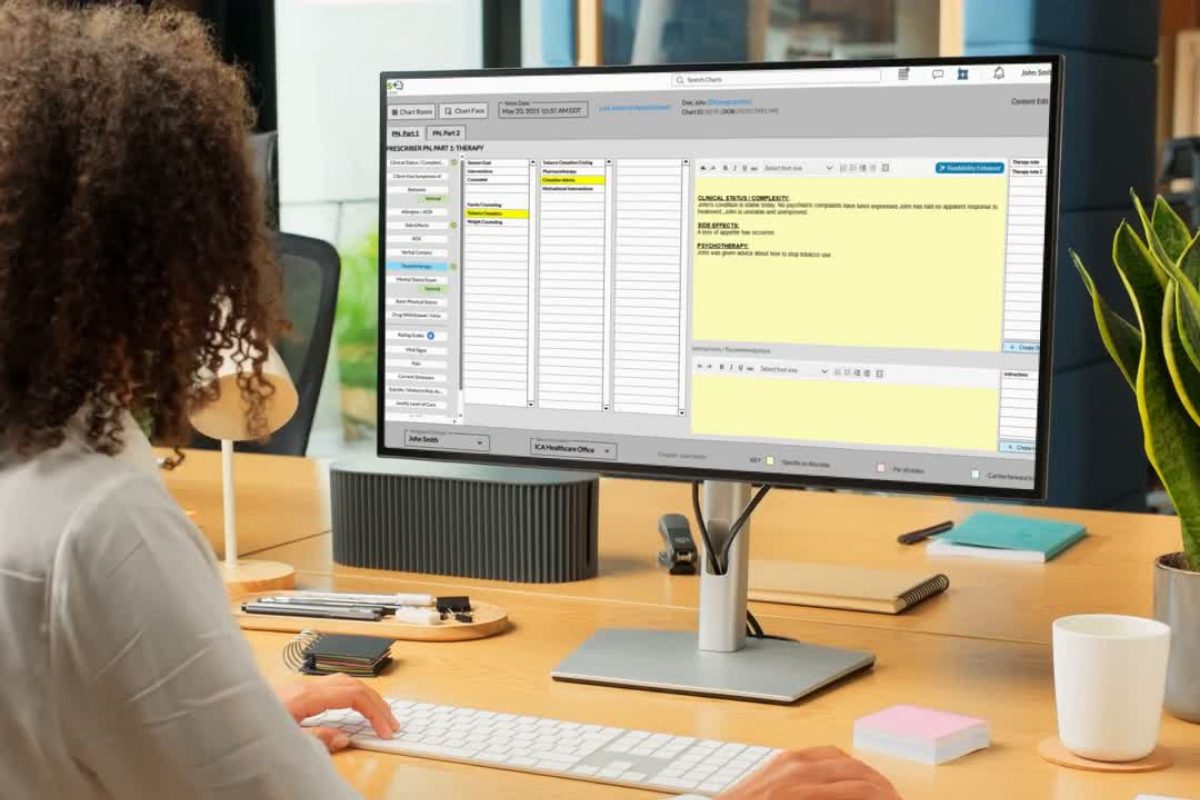Blog > Practice Management > Treatment Planning in Counseling: What It Is and How Software Improves It
Treatment Planning in Counseling: Why Software That Tracks Outcomes Matters
Effective treatment planning in counseling depends on tools that link goals to measurable progress. ICANotes treatment plan software combines outcome tracking, automated narratives, and over 100 clinical assessments to help behavioral health clinicians create data-driven, audit-ready treatment plans that enhance therapy outcomes. This article explores why outcome-driven treatment planning matters, how ICANotes compares to other behavioral health EHR platforms like TherapyNotes, SimplePractice, TheraNest, and Valant, and what best practices clinicians can apply to make treatment planning more effective.

Last Updated: October 29, 2025


What You'll Learn
- Why outcome-driven treatment planning is essential in behavioral health
- Key features of effective treatment planning systems
- How ICANotes integrates therapy outcomes measures directly into documentation
- How ICANotes compares to other treatment plan software like TherapyNotes, SimplePractice, TheraNest, and Valant
- Best practices for treatment planning in counseling that demonstrate measurable client progress
In behavioral health care, treatment planning in counseling is only as effective as its ability to demonstrate measurable progress. Clinicians need treatment planning software that not only lists goals but also integrates therapy outcomes measures directly into documentation, creating a clear picture of client improvement.
Unfortunately, many behavioral health EHR systems provide only basic modules that capture problems and goals but fail to connect those plans to measurable outcomes. ICANotes takes a different approach. With its extensive goal/objective libraries and over 100 built-in clinical assessments, ICANotes equips clinicians to create treatment plans that not only meet compliance standards but also drive measurable improvements in care.
Why Outcome-Driven Treatment Planning Matters
The Role of Routine Outcome Monitoring
Routine outcome monitoring refers to the systematic use of standardized tools to track symptom change, functioning, and quality of life. Research shows that outcome monitoring can improve care, especially when clinicians adjust treatment based on data [1, 2]. Without it, clinicians risk missing early signs of stalled progress or treatment resistance.
Benefits of Measurement-Based Care
Integrating therapy outcomes measures into treatment planning helps clinicians move from guesswork to evidence-based decisions. Here are some key benefits of measurement-based care:
- Clarity: Goals are transformed into measurable benchmarks.
- Accountability: Progress is documented and visible.
- Compliance: Accrediting bodies and payers increasingly expect outcome data.
- Patient engagement: Patients who see evidence of progress are more motivated to stay in care.
The challenge is that many EHRs lack built-in tools to make outcome measurement seamless. Clinicians are left juggling paper forms, external spreadsheets, or separate software. This is where ICANotes provides a critical advantage.
Key Elements of an Effective Outcome-Tracking Treatment Plan
To be clinically meaningful, a treatment plan should include:
- Baseline measures. Use validated tools at intake to establish a starting point.
- Goals tied to measures. For example: “Reduce PHQ-9 from 15 to below 7 within 12 weeks.”
- Regular reassessments. Scheduled at intervals that match client needs.
- Trend visualization. Graphs or tables that show progress over time.
- Decision points. Built-in triggers for plan review when progress is insufficient.
- Narrative integration. Measurement results tied directly into clinical notes.
- Client involvement. Use portals or session discussions to share outcomes.
- Audit readiness. Documentation that clearly shows goals, measures, and adjustments.

Sample Outcome-Tracking Counseling Treatment Plan
Client Information
- Client Name: Jane D.
- Age: 35
- Diagnosis: Major Depressive Disorder, Recurrent, Moderate (F33.1)
- Date of Plan: 10/28/2025
- Provider: Dr. A. Smith, LPC
- Next Review Date: 12/28/2025
Presenting Problems
Client reports persistent low mood, loss of motivation, fatigue, and difficulty maintaining concentration for over six months. Symptoms interfere with work performance and daily functioning. Baseline assessment completed using PHQ-9, with a score of 17 (moderately severe depression).
Clinical Formulation
Client’s depressive symptoms are related to perfectionistic thinking patterns, unresolved grief, and social withdrawal. Strengths include strong insight, supportive relationships, and willingness to engage in therapy.
Outcome Measures
| Domain | Tool | Baseline Score | Target Score | Review Interval |
|---|---|---|---|---|
| Depression | PHQ-9 | 17 | ≤ 7 | Every 4 weeks |
| Anxiety | GAD-7 | 12 | ≤ 5 | Every 4 weeks |
| Functioning | WHO-5 | 32% | ≥ 60% | Every 8 weeks |
Treatment Goals, Objectives, and Interventions
Goal 1: Reduce Depressive Symptoms
- Objective 1.1: Decrease PHQ-9 score from 17 to ≤ 7 within 8 weeks.
- Interventions:
- Provide weekly CBT sessions targeting cognitive distortions and behavioral activation.
- Assign daily mood tracking through patient portal (PROM).
- Review PHQ-9 every 4 weeks to monitor progress.
- Outcome Tracking: If PHQ-9 does not improve after 8 weeks, modify plan to include medication consult.
Goal 2: Improve Anxiety Management and Coping Skills
- Objective 2.1: Decrease GAD-7 score from 12 to ≤ 5 within 10 weeks.
- Interventions:
- Teach grounding and breathing techniques.
- Incorporate exposure hierarchy for social situations.
- Use GAD-7 every 4 weeks to assess improvement.
- Outcome Tracking: Review trend collaboratively with client during sessions.
Goal 3: Enhance Daily Functioning and Social Engagement
- Objective 3.1: Increase WHO-5 well-being score from 32 % to ≥ 60 % within 12 weeks.
- Interventions:
- Encourage two social activities per week.
- Introduce values-based goal setting.
- Reassess WHO-5 every 8 weeks.
- Outcome Tracking: Client self-reports via patient portal; data feeds into next treatment plan review.
Plan Review and Adjustment
Outcome measures will be re-administered per schedule. If no clinically significant change is observed (less than 20 % improvement in scores), interventions and frequency will be modified. Progress and clinical decisions will be documented in progress notes to ensure compliance and audit readiness.
Client Involvement
Client participated in setting goals, selecting measures, and reviewing baseline results. Outcome data will be shared at each session to reinforce engagement and celebrate progress.
Clinician Signature
___________________________ Date: ____________
Access Our Sample Treatment Plan Library
Get instant access to our full library of sample treatment plans.

How ICANotes Supports Measurement-Based Treatment Planning in Counseling
Over 100 Built-in Assessments
ICANotes offers an extensive library of assessments including PHQ-9, GAD-7, DAST-10, C-SSRS, PCL-5, ASRS, AIMS, DASS-21, and many more. These tools cover symptom severity, trauma, substance use, cognition, and side effects — allowing clinicians to measure across domains without leaving the system.
Integration into Treatment Plans and Notes
Unlike many EHRs, ICANotes does more than store assessment scores. Results flow into charts, link to treatment plan objectives, and can be referenced directly in progress notes. This integration makes it easy to show whether a goal is being met and adjust the plan accordingly.
Narrative and Compliance Support
ICANotes automatically generates narrative text for treatment plans, ensuring they meet regulatory and payer requirements. This reduces typing time while still producing thorough documentation. In fact, ICANotes aligns with Joint Commission and CARF standards requiring measurable goals, progress notes tied to interventions, and documented plan reviews. For Medicaid and CMS audits, the system supports clear evidence of measurable improvement, reducing risk of denial. Because assessments and outcomes are tied directly into the treatment plan, documentation is not only clinically sound, it is audit-ready.
Workflow Efficiency
Because assessments, treatment planning, and billing are integrated, clinicians don’t need to duplicate work or toggle between systems. Training is included in the subscription, lowering barriers to adoption.
How Competing Platforms Handle Treatment Planning
TherapyNotes
TherapyNotes offers a treatment plan module and outcome measures like PHQ-9, GAD-7, and CAGE-AID via the client portal [3]. They recently launched an “Insights” tab that graphs trends [4]. However, its outcome library is smaller than ICANotes’, and outcomes are less deeply embedded in treatment planning.
SimplePractice
SimplePractice is widely used for small practices because of its client portal and telehealth features. Its treatment plan templates are flexible but outcome tracking is less comprehensive, often requiring spreadsheets or external tools [5].
Ensora Health (TheraNest)
TheraNest provides basic problem/goal/objective templates and optional Wiley Practice Planner libraries. However, outcome tracking is minimal and often requires third-party integrations [6].
Valant
Valant supports measurement-based care and offers robust dashboards. But at $300+/month per provider with modular add-on costs, it is less accessible to small and mid-size practices [7].
Why Outcome Tracking is the Differentiator
Comparing platforms shows a clear divide. ICANotes and Valant support full measurement-based care, while TherapyNotes, SimplePractice, and TheraNest remain more focused on documentation basics or client convenience.
For clinicians, the ability to track and respond to outcomes is increasingly required by insurers, regulators, and accrediting bodies. It also helps patients see tangible progress, enhancing engagement and satisfaction. Payers such as Medicaid MCOs and commercial carriers are shifting toward value-based models, where outcome data is no longer optional. Federal initiatives like CMS’s Quality Payment Program and ONC certification criteria emphasize measurement-based care as a compliance expectation. By embedding outcome tools into the workflow, ICANotes keeps clinicians ahead of these mandates.
Treatment Planning Best Practices for Counselors
To maximize the value of outcome tracking in treatment planning:
- Start with 2–3 core measures that reflect the main issues.
- Set measurable goals tied to those scales.
- Schedule reassessments consistently.
- Use outcome trends to guide treatment adjustments.
- Share results with patients to enhance engagement.
- Document both scores and the clinical actions taken in response.
For effective treatment planning in counseling, clinicians should pair measurable goals with standardized therapy outcomes measures and reassess regularly. If progress plateaus, update the plan with new strategies, such as adding a CBT module, shifting to trauma-focused care, or integrating a medication consult. Document both the clinical reasoning and the measurable benchmarks so the record reflects not just activity, but evidence-based decision-making. Using an integrated treatment planning system like ICANotes makes this process seamless, ensuring every plan is clinically meaningful and data-driven.
FAQs: Treatment Planning and Outcome Measurement
Conclusion: Advancing Treatment Planning in Counseling With ICANotes
Treatment planning that tracks outcomes is the future of behavioral health documentation. ICANotes is uniquely positioned to help clinicians deliver on this standard by combining an extensive library of more than 100 built-in assessments with seamless integration between assessments, treatment plans, and progress notes. Its automated narrative generation supports compliance while saving time, and its pricing structure makes advanced clinical tools accessible to practices of all sizes. While other platforms such as TherapyNotes, SimplePractice, TheraNest, and Valant offer useful features, none strike the same balance of clinical depth, workflow efficiency, and affordability. For practices committed to measurable, evidence-based care, ICANotes turns treatment planning from a static requirement into a dynamic process that drives real progress for patients.
Ready to see how outcome-driven treatment planning can transform your documentation and client care?
Start your free trial of ICANotes today and experience the difference of a behavioral health EHR built to track progress, improve outcomes, and simplify compliance.
Start Your 30-Day Free Trial
Experience the most intuitive, clinically robust EHR designed for behavioral health professionals, built to streamline documentation, improve compliance, and enhance patient care.
- Complete Notes in Minutes - Purpose-built for behavioral health charting
- Always Audit-Ready – Structured documentation that meets payer requirements
- Keep Your Schedule Full – Automated reminders reduce costly no-shows
- Engage Clients Seamlessly – Secure portal for forms, messages, and payments
- HIPAA-Compliant Telehealth built into your workflow
Complete Notes in Minutes – Purpose-built for behavioral health charting
Always Audit-Ready – Structured documentation that meets payer requirements
Keep Your Schedule Full – Automated reminders reduce costly no-shows
Engage Clients Seamlessly – Secure portal for forms, messages, and payments
HIPAA-Compliant Telehealth built into your workflow
Related Posts
About the Author
Dr. October Boyles is a behavioral health expert and clinical leader with extensive expertise in nursing, compliance, and healthcare operations. With a Doctor of Nursing Practice (DNP) and advanced degrees in nursing, she specializes in evidence-based practices, EHR optimization, and improving outcomes in behavioral health settings. Dr. Boyles is passionate about empowering clinicians with the tools and strategies needed to deliver high-quality, patient-centered care.







